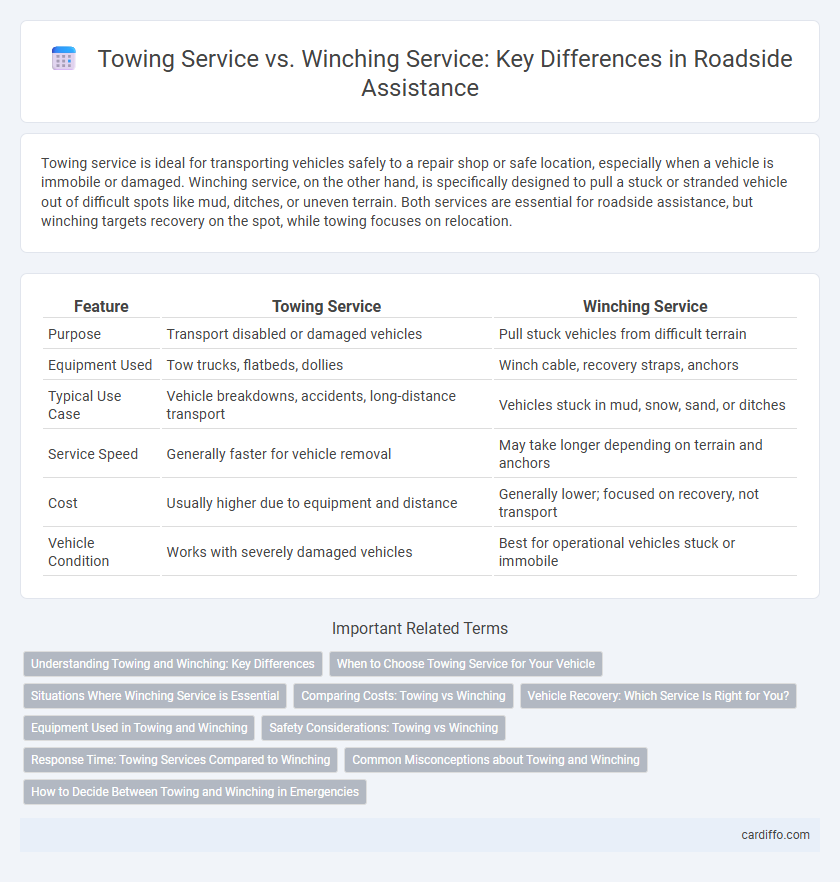Towing service is ideal for transporting vehicles safely to a repair shop or safe location, especially when a vehicle is immobile or damaged. Winching service, on the other hand, is specifically designed to pull a stuck or stranded vehicle out of difficult spots like mud, ditches, or uneven terrain. Both services are essential for roadside assistance, but winching targets recovery on the spot, while towing focuses on relocation.
Table of Comparison
| Feature | Towing Service | Winching Service |
|---|---|---|
| Purpose | Transport disabled or damaged vehicles | Pull stuck vehicles from difficult terrain |
| Equipment Used | Tow trucks, flatbeds, dollies | Winch cable, recovery straps, anchors |
| Typical Use Case | Vehicle breakdowns, accidents, long-distance transport | Vehicles stuck in mud, snow, sand, or ditches |
| Service Speed | Generally faster for vehicle removal | May take longer depending on terrain and anchors |
| Cost | Usually higher due to equipment and distance | Generally lower; focused on recovery, not transport |
| Vehicle Condition | Works with severely damaged vehicles | Best for operational vehicles stuck or immobile |
Understanding Towing and Winching: Key Differences
Towing service involves safely transporting a disabled vehicle on a flatbed or hook-and-chain truck to a repair shop or designated location, ideal for vehicles that can be moved without being stuck. Winching service uses a cable and winch mechanism to pull a vehicle out of difficult situations such as mud, ditches, or snow when the vehicle is immobile or trapped. Understanding these distinctions helps roadside assistance providers deploy the appropriate method efficiently based on the vehicle's condition and terrain challenges.
When to Choose Towing Service for Your Vehicle
Towing service is ideal when your vehicle is immobile due to severe mechanical failure, accident damage, or when it cannot be safely driven on public roads. Opt for towing if the vehicle's wheels are locked, severely damaged, or if transporting over long distances is necessary to reach a repair facility. Choosing towing ensures safe, secure transfer without risking further damage compared to winching, which is better suited for extracting vehicles stuck in minor off-road conditions or soft terrain.
Situations Where Winching Service is Essential
Winching service is essential in situations where vehicles are stuck in mud, snow, or deep ditches, making traditional towing methods ineffective. It involves using a winch cable to pull the vehicle out gently without causing further damage, ideal for off-road recoveries or when the terrain is too rough for standard towing. This service ensures safe extraction in challenging roadside conditions where immediate and controlled retrieval is necessary.
Comparing Costs: Towing vs Winching
Towing services typically incur higher costs than winching due to the extended labor and equipment usage involved, averaging $75 to $125 per hour depending on vehicle size and distance. Winching services, used for pulling vehicles from ditches or obstacles, usually cost between $100 and $200 but are often charged as flat fees for shorter recovery efforts. Choosing between towing and winching depends on the vehicle's position and damage, with towing being more expensive but necessary for longer hauls or severe immobilizations.
Vehicle Recovery: Which Service Is Right for You?
Towing service involves transporting a disabled vehicle on a flatbed or dolly to a repair shop, ideal for long-distance or severe mechanical failures. Winching service uses a cable system to pull a stuck vehicle out of ditches, mud, or snow, suitable for off-road recoveries or minor roadside incidents. Selecting the right service depends on the vehicle's condition, location, and the severity of the immobilization.
Equipment Used in Towing and Winching
Towing service primarily uses tow trucks equipped with flatbeds, wheel-lift systems, or hook and chain mechanisms, designed to transport vehicles safely on roads. Winching service relies on powerful electric or hydraulic winches with strong steel cables or synthetic ropes to pull stuck or immobilized vehicles from difficult terrains. The choice of equipment depends on the vehicle's condition and location, with winching ideal for off-road recovery and towing suited for road transport.
Safety Considerations: Towing vs Winching
Towing service involves transporting a vehicle by lifting or pulling it onto a tow truck, requiring secure hitching to ensure road safety and prevent damage during transit. Winching service uses a cable or rope to pull a vehicle out of difficult situations like ditches or mud, demanding careful control to avoid snapback hazards and ensure operator safety. Both services prioritize safety protocols, with towing focusing on load stability and winching emphasizing controlled cable tension and proper positioning.
Response Time: Towing Services Compared to Winching
Towing services typically offer faster response times compared to winching services due to their ability to quickly transport vehicles from various locations, especially on highways and busy roads. Winching services often require more time to stabilize and recover stuck or immobilized vehicles, particularly in off-road or difficult terrain scenarios. Efficient dispatch systems and strategically positioned tow trucks further reduce wait times for towing assistance, enhancing overall roadside recovery speed.
Common Misconceptions about Towing and Winching
Common misconceptions about towing and winching often lead to improper roadside assistance choices. Many assume towing solely involves pulling a vehicle on flat ground, whereas winching is specialized for extracting stuck vehicles from difficult terrain or obstacles. Understanding that towing and winching serve distinct purposes ensures timely and effective roadside recovery, reducing the risk of further vehicle damage.
How to Decide Between Towing and Winching in Emergencies
In emergencies, deciding between towing and winching depends on vehicle condition and terrain. Towing is ideal for transporting operable vehicles on flat surfaces, while winching is necessary to extract stuck vehicles from mud, snow, or ditches. Assessing the vehicle's immobilization and environmental challenges ensures the appropriate roadside recovery method is selected.
Towing service vs winching service Infographic

 cardiffo.com
cardiffo.com